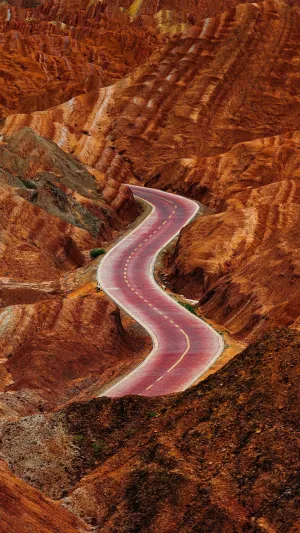Despite thousands of years of human civilization, our planet still holds secrets in remote corners, where awe-inspiring and otherworldly geological landscapes continue to captivate those who discover them.
In this exploration, we delve into four remarkable sites that showcase the Earth's astounding beauty and diversity.
1. Colorful Danxia Scenic Area, China:
Nestled within the Zhangye Qilian Mountain range, the Colorful Danxia Scenic Area in China is a geological masterpiece that spans approximately 40 kilometers from east to west and 5 to 10 kilometers from north to south. Situated at altitudes between 2,000 and 3,800 meters, this captivating region covers over 300 square kilometers.
Characterized by thousands of cliffs and mountains, the landform displays vibrant colors of bright red and reddish-brown, creating a surreal and harmonious spectacle. The term "Danxia" refers to isolated peaks and peculiar rocks formed by the long-term weathering and water erosion of red sandy conglomerate, dating back to the pre-Jurassic to Tertiary period, nearly 2 million years ago.
Covering an extensive 50 square kilometers, the Zhangye Colorful Danxia is a haven for both tourism and geological research. It stands as the most typical representation of the Danxia landform in the arid regions of northern China, boasting complexity, ornamental richness, and a majestic, dangerous, and beautiful landscape.
2. Rainbow Mountain, Peru:
Situated in the Andes Mountains of Peru, Rainbow Mountain is a magical natural wonder that lives up to its name. Unlike traditional rainbows that appear after rain, this mountainous region exhibits a breathtaking array of colors even in dry weather.
The Andes' rolling mountains, adorned with various hues, collectively form an extraordinary natural scenic spot resembling a massive rainbow-colored canvas. However, reaching Rainbow Mountain is no easy feat, given its high altitude of approximately 5,300 meters. Tourists typically drive to an elevation of 4,500 meters before embarking on a challenging climb, marked by the effects of altitude sickness in the latter part of the journey.
3. Deadvlei, Namibia:
Found within the salt pans, Deadvlei in Namibia is a striking white clay depression that has remained barren and lifeless for nearly 900 years. The harsh effects of climate change have led to the interruption of waterways by dunes, depletion of groundwater, and the slow demise of trees under the scorching sun.
This mysterious and desolate landscape appears as a cruel joke orchestrated by nature. Dead Vlei's salt pans serve as a testament to the relentless forces of time and climate, rendering a hauntingly beautiful, yet eerie, expanse.
4. The Eye of the Sahara, Mauritania:
Spanning an impressive diameter of 48 kilometers, visible even from space, the Eye of the Sahara in Mauritania is a colossal concentric circle. The central region, resembling a flat pupil, is surrounded by low hills and stretches a vast expanse of yellow sand in the distance.
Initially thought to be an impact crater, scientists now believe that the Eye of the Sahara resulted from terrain uplift and erosion. Divided into three distinct layers, the concentric circles create an optical illusion of an enormous eye, captivating all who gaze upon it from above.
These four extraordinary natural landscapes remind us of the Earth's boundless wonders, hidden in remote corners waiting to be explored. From the vibrant Danxia landforms in China to the rainbow-colored mountains of Peru, the desolate Deadvlei in Namibia, and the mesmerizing Eye of the Sahara in Mauritania, each site offers a unique glimpse into the planet's geological history and the forces that continue to shape it.





